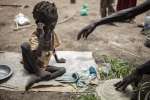UNHCR describes alarming health and nutrition situation in South Sudan camps
News Stories, 24 August 2012
GENEVA, August 24 (UNHCR) – The UN refugee agency said on Friday it is concerned by the alarming health and nutrition situation for some 170,000 refugees in South Sudan, particularly among children under the age of five and in the two camps of Yida and Yusul Batil.
"The mortality rate for children less than five across all the camps is above the emergency threshold," said Paul Spiegel, UNHCR's health expert and deputy director for the Division of Programme Support and Management, said during a press conference. "In Batil in Upper Nile, in Yida in Unity state, they are double the emergency threshold of over four deaths for 10,000 per day, which is four times the normal rate that one would expect in sub-Saharan Africa."
Malnutrition rates are also very high, particularly in Yusuf Batil camp which hosts some 34,000 refugees originally from the Blue Nile region of neighboring Sudan. According to Spiegel, the global acute malnutrition rate in this camp is close to 40 percent among children younger than five, while severe malnutrition affects 13.4 percent of children in the same age group. These children and their mothers are currently being treated under a special feeding program.
In Yusuf Batil there are measles cases, and UNHCR's partners are undertaking a mass immunization campaign for children. With the rainy season and the cold, there is also an increase in water-borne diseases across all camps, as well as malaria and respiratory tract infections.
Many of these diseases are preventable. UNHCR and its partners are carrying out an extensive health, nutrition and hygiene promotion campaign. Aid agencies are also stepping up the delivery of food and non-food items.
UNHCR, for example, is increasing its distribution of plastic sheeting and soap. The agency is also providing refugee families with more bed mosquito nets, which are crucial in the fight against malaria. More latrines are also being built, while existing ones are being kept clean with the help of the refugee communities.
The community outreach efforts are starting to result in a reduction of diarrheal cases. Despite these efforts, Spiegel warns of the risk of a cholera outbreak due to the poor water and sanitary conditions in the camps during the rainy season.
"Cholera is a possibility. We are even considering measures that are not done so often, such as providing cholera vaccine for the refugee population and possibly the host population as well. This requires approval by the Ministry of Health," Spiegel said.
Since April, the number of Sudanese refugees seeking safety in South Sudan has swelled from 99,000 to 170,000. These refugees are settled in extremely remote and floodable land areas with little or no road infrastructure, forcing aid agencies to deliver aid by air or by barge.

























































